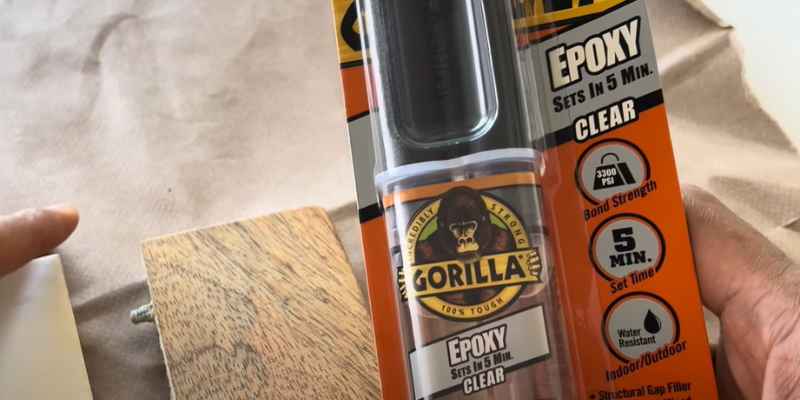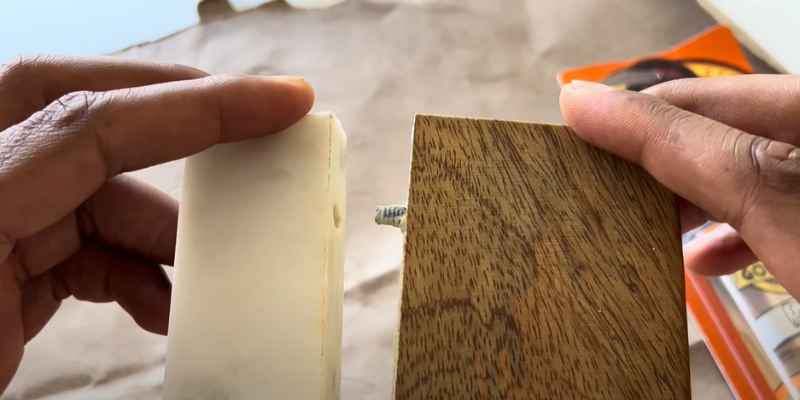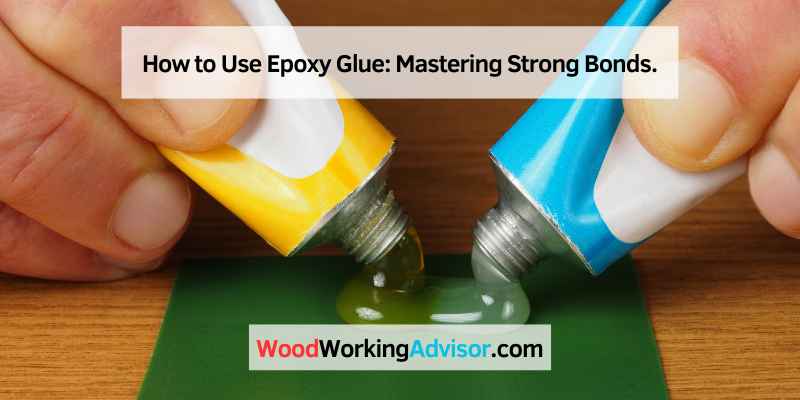To use epoxy glue, roughen the surfaces you want to bond, prepare the application syringe, mix the epoxy resin and hardener quickly, apply a small amount of glue to the surfaces you’re bonding, and carefully remove any excess epoxy. Epoxy glue is a two-part adhesive that can bond a wide range of surfaces, including metal, glass, wood, ceramics, and concrete.
It provides a strong and durable bond and is commonly used in carpentry and woodwork, fibreglass repairs, jewellery making, and more. However, curing times can be slow, and without modification, cured epoxies can be brittle. We’ll cover everything you need to know about using epoxy glue, including tips on how to apply it and the projects it’s best suited for.

How To Use Epoxy Glue
To use epoxy glue, start by roughening the surfaces you want to bond with sandpaper, then prepare an application syringe and mix the epoxy resin and hardener. Apply a small amount of glue to the surfaces and remove any excess.
Epoxy glue works best with a wide range of materials including metal, glass, wood, ceramics, tile, and concrete.
of epoxy glue to both surfaces. … Remove any excess glue with a clean rag or paper towel. … Let the epoxy glue harden for at least 30 minutes. … For better results, let the epoxy sit overnight to cure completely.
Before using epoxy glue, it’s best to make sure that the surfaces you are bonding are roughened. Use sandpaper to roughen the surfaces you’re going to bond. This helps create a more secure bond between the surfaces. Once the surface is roughened, prepare the application syringe that you’re going to use to apply the glue.
The next step is to mix the epoxy resin and hardener quickly. For this, retract the plunger on the application syringe and add equal parts of the resin and hardener. Then, push the plunger back in and mix for at least a minute until the mixture is homogeneous.
After mixing, apply a small amount of epoxy glue to the surfaces you’re bonding. Remember to apply it in a thin layer, as using too much can weaken the bond. Remove any excess glue with a clean rag or paper towel.
Next, let the epoxy glue harden for at least 30 minutes. This gives the glue time to set and creates a stronger bond. For better results, let the epoxy sit overnight to cure completely. This ensures that the bond is strong and durable.
Epoxy glue can be used for a wide range of projects, including carpentry and woodworking, fibreglass repairs, filling gaps in wood and metal, reinforcing bolts, and even jewellery making. However, it’s important to note that without modification, cured epoxies can be brittle, and proper curing requires exact mix ratios and slow cure times. Nonetheless, the impressive bonding strength of epoxy glue sets it apart from its one-component counterpart, making it a popular choice for bonding rubber, metal, wood, glass, plastic, and masonry.
Epoxy For Different Projects
Epoxy glue can be used for various projects, such as carpentry and woodwork, repairs with fiberglass, filling gaps in wood and metal, and jewelry making. To use epoxy glue, surfaces must be roughened with sandpaper, and the epoxy resin and hardener must be mixed quickly before applying a small amount to the surface and removing excess glue carefully.
Two-part epoxies bond well with metal, wood, glass, plastic, and masonry. However, without modification, cured epoxies can be brittle, require exact mix ratios, and may have slow cure times.
Epoxy glue is a two-part adhesive that bonds surfaces together quickly and securely. It is highly versatile and can be used for a wide range of projects, from carpentry and woodwork to jewelry making. Here are some specific projects where epoxy glue can be the best option.
Carpentry And Woodwork
Epoxy glue is ideal for woodworking projects, especially when it comes to bonding wood to other materials such as metal, ceramics, or glass. It can also be used to fill cracks and gaps in wood, creating seamless, unbroken surfaces. Epoxy glue is waterproof and can withstand exposure to heat and cold, making it a popular adhesive for outdoor furniture and structures.
Repairs Involving Fiberglass
Fiberglass is a commonly used material in many industries. When it comes to repairing fiberglass, epoxy glue is the most effective adhesive. It cures hard and strong, creating a durable bond. With its ability to fill gaps and cracks, epoxy glue can repair even severely damaged fiberglass surfaces.
Filling Gaps In Wood And Metal
Epoxy glue works wonders for filling gaps in wood and metal. It can be used to fill gaps in wooden furniture, countertops, and floors, creating a seamless finish. When it comes to metal, epoxy glue can be used to repair holes or dents in car bodies or bikes.
Reinforcing Bolts
Epoxy glue is commonly used to reinforce bolts in machinery, especially in high-stress areas where the bolt is likely to loosen or fail under pressure. By applying epoxy glue to the bolt and the surrounding area, the bond between the bolt and the metal can be strengthened, preventing it from coming loose or failing.
Jewelry Making
Epoxy glue is an excellent adhesive for jewelry making. It allows for precision bonding and can be used to attach metal to a variety of materials such as glass, stone, or wood. Its thin consistency makes it easy to apply, even in small spaces, and it can create a long-lasting bond, ensuring your jewelry stays intact.
Other Projects
Epoxy glue is highly versatile and can be used for many other projects such as repairing ceramics, plastic, or concrete. It is also ideal for use in hobby projects, where precise bonding is required. With its strong bond and ability to fill gaps and cracks, it is a popular adhesive in the DIY community.
In conclusion, epoxy glue is an excellent adhesive for a wide range of projects. Its versatility, strength, and durability make it an excellent choice for everyday repairs, woodworking, and DIY projects. By understanding its uses and how to apply it, you can create strong and long-lasting bonds for your projects.
Disadvantages Of Epoxy Glue
When it comes to using epoxy glue, it’s important to be aware of its disadvantages. Some cons include brittle cured epoxies, exact mix ratio requirements, and slow cure times. Despite these downsides, epoxy glue is still a versatile adhesive that can be used in a variety of projects such as carpentry, fiberglass repair, and jewelry making.
Disadvantages of Epoxy Glue:
While epoxy glue is an excellent adhesive for a variety of purposes, it has a few disadvantages. Here are some of the drawbacks to using this type of glue:
Cured epoxies can be brittle without modification:
One of the main disadvantages of epoxy glue is that it can be brittle after curing, which can cause it to crack or break over time. However, this can be rectified by modifying the epoxy using fillers or lightweight additives to increase its flexibility and durability.
Exact mix ratios required for proper curing:
Proper curing of two-part epoxies requires exact mix ratios. If the mix ratios are not correct, the epoxy may not cure properly, which can lead to a weakened bond or complete failure of the joint. It is, therefore, important to follow the manufacturer’s instructions on mixing the epoxy carefully.
Slow cure times:
Another disadvantage of epoxy glue is its slow cure time. It can take several hours or even days for the epoxy to set and cure, depending on the type of epoxy used. This delay can be a problem if you need to use the glued item immediately.
In conclusion, epoxy glue is an excellent adhesive for a wide range of applications. However, it is important to be aware of its drawbacks, such as its brittle nature without modification, precise mix ratios required, and slow curing times. By understanding these limitations, you can use epoxy glue effectively and ensure that it provides a long-lasting bond.

Best Substrates For Epoxy Glue
Epoxy glue is a versatile adhesive that can be used on a wide range of substrates such as metal, wood, fiberglass, and even jewelry. Roughening the surfaces to be bonded, preparing the application syringe, and mixing the epoxy resin and hardener are some key steps to follow when using epoxy glue successfully.
When it comes to bonding materials together, epoxy glue is one of the most versatile and effective options out there. However, not all materials are equally suited for use with epoxy. In this section, we’ll take a closer look at the best substrates for epoxy glue, breaking them down by material type.
Metal
Epoxy glue is an excellent choice for bonding metal surfaces, including steel, aluminum, copper, and brass. It can be used for a variety of applications, from repairing broken parts to securing bolts and reinforcing joints. When working with metal, be sure to clean the surfaces thoroughly and rough them up with sandpaper or a wire brush before applying the epoxy glue.
Glass
Glass can be a bit more challenging to bond with epoxy, as it’s a non-porous material that doesn’t provide much adhesion. However, with the right approach, it is certainly possible to create a strong bond between glass surfaces. Make sure to clean the glass with rubbing alcohol or acetone and use a clear, non-yellowing epoxy for best results.
Wood
Wood is one of the most common materials used with epoxy glue, as it is highly versatile and flexible. Epoxy is particularly useful for filling gaps in wood or reinforcing weak spots in furniture or cabinetry. For best results, sand the wood surfaces thoroughly and apply the epoxy to both surfaces before bonding them together.
Ceramics
Ceramics can be brittle and difficult to bond, so it’s important to choose the right epoxy for the job. Look for an epoxy that is specifically designed for use with ceramic materials and follow the manufacturer’s instructions carefully. Clean the surfaces with rubbing alcohol or acetone and allow the epoxy to cure fully before handling the ceramic item.
Tile
Tile is similar to ceramic in that it can be brittle and hard to bond. However, epoxy glue can be a great choice for repairing broken tiles or securing loose ones. Before applying the epoxy, make sure to clean the surfaces with a tile cleaner or rubbing alcohol and allow the tile to dry completely.
Concrete
Concrete is a porous material that can be challenging to bond without the right adhesive. Epoxy glue is an excellent choice for fixing cracks or bonding new concrete to existing surfaces. Make sure to clean the concrete thoroughly and rough up the surface with a wire brush or sandpaper before applying the epoxy.
Untreated Plastic And Elastomer Not Recommended
While epoxy glue can be effective with a wide range of materials, it is generally not recommended for use with untreated plastic or elastomer. These materials can be difficult to bond due to their low surface energy and may require a specialized adhesive. If you need to bond plastic or elastomer, be sure to research the best type of adhesive for the specific material you’re working with.
In conclusion, knowing the best substrates for epoxy glue is essential for achieving the strongest bond possible. By following these guidelines and choosing the right type of epoxy for your material, you can ensure a long-lasting and durable bond.
Frequently Asked Questions Of How To Use Epoxy Glue
When Should You Use Epoxy Glue?
Epoxy glue is suitable for a wide range of projects, including carpentry, fibreglass repairs, filling gaps in wood and metal, reinforcing bolts, and jewellery making. It can bond rubber, metal, wood, glass, plastic, and more. However, cured epoxies can be brittle, and proper cure times and mix ratios are necessary.
Sandpapering the surfaces to be bonded, preparing the syringe, mixing the epoxy resin and hardener quickly, and removing excess glue are all required.
What Do You Use To Apply Epoxy Adhesive?
To apply epoxy adhesive, you can follow these steps: roughen up the surface, prepare the application syringe, mix the epoxy resin and hardener, apply a small amount to the surfaces, and remove excess glue carefully. Epoxy is often used to bond a range of substances such as metal, wood, glass, ceramics, and concrete.
However, cured epoxies can be brittle and slow to cure. Two-part epoxies bond well with Rubber, metal, wood, glass, plastic, masonry, and pretty much any other substrate except for untreated plastic and elastomer.
What Are The Disadvantages Of Epoxy Glue?
The disadvantages of using epoxy glue include brittleness when cured without modification, the need for exact mix ratios, and slow cure times.
What Does Epoxy Glue Work Best With?
Epoxy glue works best with a wide variety of substrates, including metal, wood, glass, ceramics, and masonry. However, it may not work well with untreated plastic and elastomer. This two-part epoxy adhesive bond is strong and can be used for carpentry, woodwork, fiberglass repairs, jewelry making, filling gaps in wood and metal, and reinforcing bolts.
It is essential to mix the resin and hardener in exact ratios and roughen the surfaces before applying the adhesive.
Conclusion
Using epoxy glue can be an effective way to bond a variety of materials together. From carpentry and woodwork to jewellery making and beyond, the possibilities are endless. By following the proper application techniques, you can achieve a strong and durable bond for your projects.
Keep in mind the potential disadvantages of epoxy glue, such as slow cure times and the need for exact mix ratios, but with careful attention, you can overcome these challenges and create something truly remarkable.


